Robotics Education Journal
 11/19/2019
11/19/2019 Steve Trimble of AviationWeek.com reported November 18 from the Dubai Airshow that the Chinese exhibited a prototype ornithopter drone dubbed the “Orthopaedist’s Ornithopter,” as branded on the founding company’s business cards. Beijing-based Implant Aircraft Co. Ltd. is testing multiple versions of the machine, which is privately developed but intended for the Chinese military. The goal is a noiseless, tactical drone with a 2-hour endurance.
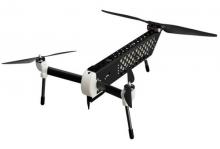 11/10/2019
11/10/2019 From leaked photos of the much-anticipated DJI Mavic Mini to an up-close view of the new Jupiter Tricopter, a “game changing UAS”, the latest edition of David Place’s Unmanned Systems News (USN) is a must-read packed with these stories and much more. Btw, in this release, David noted in his intro: "ALCON - A SPECIAL THANK YOU to all of you Veterans who have served, or are currently serving, our great country! I sincerely hope that each of you enjoy a terrific Veterans Day and thanks again for your service! Please find attached the current edition of my Unmanned Systems News which includes the title of the original article, a couple of relevant sentences to pique your interest and a hyperlink to the original article. I hope that you find this compilation useful. This is my THIRTY-FOURTH newsletter for calendar year 2019, hence the designation # 19 - 34." We echo David's Veterans Day wishes to our servicemembers! Given the rich content in this edition of USN, NREF is posting David's entire USN#19-34 edition, below. You can subscribe to the free USN newsletter simply by emailing David Place—and we highly recommend it!
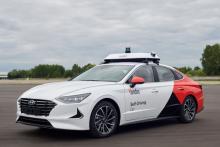 11/09/2019
11/09/2019 November 8, 2019 SOUTHFIELD, MI – Five Lawrence Technological University students and LTU computer science professor CJ Chung will work with a Korean auto parts company and a Russian tech giant to create a taxi service from Detroit’s TCF Center to downtown Detroit hotels for the 2020 North American International Auto Show in June.
LTU will assist Hyundai Mobis, the parts and service arm of the Korean automaker, and the Russian technology company Yandex, in the development of 10 four-passenger sedans in the largest demonstration to date of Yandex’s robotic taxis in the United States. The vehicles will be programmed to take passengers to their destinations, although there will be a driver who could take control if needed.
 11/05/2019
11/05/2019 A new robot is showing promise to control lionfish, an invasive species that is in the water of the Bahamas and spreading south. The Guardian can dive hundreds of feet below the surface and stun lionfish with electrodes, then suck them into a holding tank. As it happens, the lionfish is a big hit on restaurant menus. The Guardian was developed by renowned roboticist inventor Colin Angle, who also developed the Roomba. Angle launched the “Robots in Service of the Environment” nonprofit to support the project. With no natural predators and with potent venom, lionfish can reduce the fish population around a coral reef by as much as 79%.
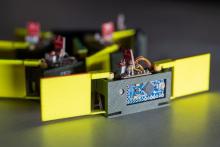 11/02/2019
11/02/2019 The shape of things to come may include self-assembling bridges that then disassemble into interchangeable pieces termed “smarticles”. Swarms of smarticles might then move on to reassemble at another time and place into a building or other structure of utilitarian use for the military in the field. As sci-fi as this sounds, smarticles R&D is well underway.
 10/26/2019
10/26/2019 Renowned RC blogger and enthusiast Jim T. Graham recently interviewed Lucien Miller of Innov8tive Designs, on RCGroups.com, a great website for drone and RC hobbyists that we heartily recommend. Jim T. has also posted an article on BADASS Power Systems to the site that you’ll want to read. Below, we’ve provided relevant links and fascinating highlights of the interview. These suggest that the electric motor market is vaulting forward in fascinating ways—for that reason, we believe this technical summary is a must read!
 10/23/2019
10/23/2019 HitecRCD began engineering servos for non-hobby applications in the last several years and accumulated the experience and expertise to enter the drone market. As reported by InsideUnmannedSystems.com, Shawn Spiker, drone services sales and training manager at Hitec said: “We were already supplying servos, supplying foam aircraft and making transmitters, and we had all the engineering attributes to make our own complete drone—so there was nothing we had to reach outside for. The company decided to create a more competitive offering and developed a new product line from scratch.”
 10/16/2019
10/16/2019 Piaggio Fast Forward (PFF) debuted its “gita” robot this week, which can follow people around carrying up to 40 pounds of stuff, from gym bags to computer tablets to groceries. The gita is operated with simple push-button controls. It senses its operator and follows in sync with the operator up to six mph. The gita can scale inclines of up to 16%, and operates on hard paths, floors and sidewalks (not snow, sand, mud or tall grass).
 10/11/2019
10/11/2019 DRONERESPONDERS is a non-profit program created to unite aerial first responders, emergency managers, and search and rescue specialists under a unified organization to help learn, train, and test with one another with the ultimate objective of maximizing drone operations for public safety.
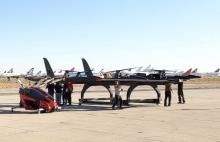 10/03/2019
10/03/2019 An anonymous tipster notified us that two full-scale electric Vertical Take-Off and Landing (eVTOL) prototypes were spotted in a test environment. The nearly all-black airframe in one photo shows a freighter design with no wheels but skids as fixed landing gear. This appears to be an unmanned cargo hauler with six hover rotors and one cruise prop.
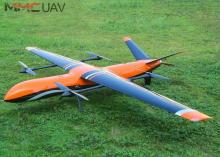 09/25/2019
09/25/2019 The new hydrone Griflion H features a record-breaking 15-hour maximum flight time. Powered by a Micromulticopter (MMC)-developed hydrogen fuel cell with a max hydrogen storage capacity of 27L, the vehicle can fly for 10 hours with a 3 kg payload.
 09/18/2019
09/18/2019 On Wednesday, September 11, 2019, Major General Poss (ret), USAF, published an open letter to the new FAA Administrator with suggestions for optimizing the business growth of the Drone industry. General Poss is a leading expert on UAS and is CEO of ISR Ideas, an intelligence, unmanned systems and cyber warfare consulting company. Owing to the letter’s length, portions are excerpted, here.
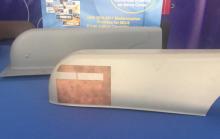 09/07/2019
09/07/2019 Different radio frequencies used in encrypted military communications require very different, custom-configured antenna shapes and sizes to optimize signal transmission and reception. The U.S. Military is testing morphing liquid metal antenna designs in order to create a system that can custom-configure antenna sizes and shapes onboard the aircraft during a mission. The goal is to reduce the total weight of a multi-frequency-capable flight system, which would otherwise have to carry the weight of several different antennas of varying sizes and shapes.
 08/26/2019
08/26/2019 An editorial posted on August 21 by nature, International Journal of Science, reported that France and Canada are convening an international committee to advise on the ethics of artificial intelligence (AI). The editorial, titled: “International AI ethics panel must be independent” endorsed the committee with the comment, “The group should be supported and shielded from undue influence.”
 08/21/2019
08/21/2019 Loosely stated, Moore’s law holds that the number of transistors in an integrated circuit on a chip, and its processing power, doubles approximately every two years. "Without any doubt, Moore's Law is well and alive. It's not dead, it's not slowing down, it's not even sick. It's well and alive," Philip Wong reported on Tuesday at the Hot Chips Conference at Stanford University. He should know, as he is head of research at Taiwan Semiconductor Manufacturing Corp.
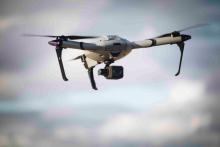 08/12/2019
08/12/2019 Atlas is a leading aerospace company specializing in the design and manufacture of UAS for law enforcement, security companies and first responders. As reported by the sUAS News, on Sunday, July 7, 2019, in Rio de Janeiro, Brazil, Atlas partnered with the Rio de Janeiro State’s Military Police to provide security at the Maracanã Stadium during the Copa America soccer tournament. This was the first time in which MESH multi-drone UAS technology has been approved for usage to secure a major sporting event.
 08/01/2019
08/01/2019 Last month Dronebelow.com reported on an interesting new inspection UAS design from Flybotix that employs a simplified propulsion system based on a pair of stacked propellers. These are enclosed in a shroud that is the body of the aircraft. The craft’s advanced stabilization system and light weight permits flight durations that are “twice as long as conventional models.”
The Xponential 2019 national conference was held April 29 to May 2nd by the Association for Unmanned Vehicle Systems International (AUVSI) at McCormick Place in Chicago. In this preview of a full conference exhibit hall gallery to be posted by The National Robotics Education Foundation (NREF) in August (our 4th year!), you will find a fascinating sample of what’s to come. This event featured some of the most advanced robots and their allied software, transport and admin support systems on the planet.
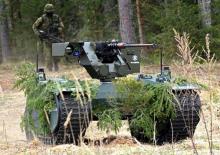 07/19/2019
07/19/2019 As reported by Military&Aerospace Electronics, support for unmanned combat vehicles for ground operations is growing in the military for a few reasons, the most important being that weaponized robots can protect human combatants’ lives. The article notes that the U.S. Army will begin field testing, in under a year, autonomous M2 Bradley fighting vehicles at Fort Carson, Colorado. Further, it states that the Army indicated last June it would be testing an unmanned ground vehicle carrying 20-to-50 millimeter canons. The vehicle is said to be capable of operating off-road or on-road. For comparison, see also the included phot of the Russian Uran-9.
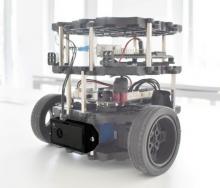 07/12/2019
07/12/2019 This lightweight, low-power ultrasound sensor can be easily mounted to your robot, and it is unaffected by reflectance or opacity of objects in its field of view of up to 160° x 160°. Sophisticated algorithms coupled with carefully selected hardware components enables mapping of the TS3’s immediate environment in real-time.
 07/06/2019
07/06/2019 At Robot Captain Crabs Cajun Seafood & Bar restaurant in Delaware, a tireless waiter named Sheldon, left, delivers food as fellow cyber employee Shirley meets and greets patrons. These new $20,000 Chinese robots greet customers and serve food, replacing the professional roles of humans. Will this become ubiquitous, threatening untold human jobs?
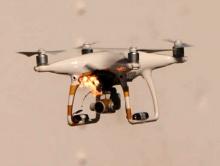 07/03/2019
07/03/2019 When hostile autonomous or remote-controlled drones probe the perimeters of forward U.S. bases, counter-UAS (C-UAS) defensive weapons are employed to neutralize these threats. Among the technologies deployed is a C-UAS laser developed by Raytheon that is mounted on a military dune buggy.
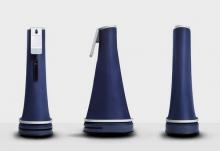 06/29/2019
06/29/2019 Cobalt Robotics makes autonomous security robots. Cobalt just closed a $35 million Series B, providing funds from investors that are slated to expand Cobalt services across the U.S. Cobalt security robots roam facilities monitoring large spaces with five dozen sensors including RGB, IR, video, thermal, ultrasound and lidar.
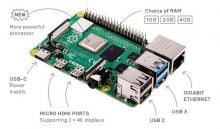 06/27/2019
06/27/2019 A new Raspberry Pi has been announced that is priced from $35. It is a micro-size, dual-display desktop computer on a small board. The hackable device has been quite popular with hobbyists, educators and students for years. One can drop the new Raspberry Pi into old projects for an upgrade. Three RAM versions are available. Software is backwards-compatible, so what one creates on a Raspberry Pi 4 will also work on older models.
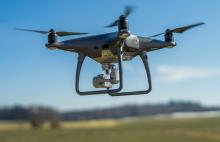 06/23/2019
06/23/2019 DJI has announced that all of their new consumer drones weighing more than 8.8 ounces (250 grams) marketed as of January 1, 2020 will include airplane and helicopter detectors and will notify drone pilots of aircraft that appear to be on a collision course with piloted drones. The detectors, powered by AirSense technology, will be integrated into new DJI drone releases; AirSense receives ADS-B signals from nearby full-scale planes and helicopters.
